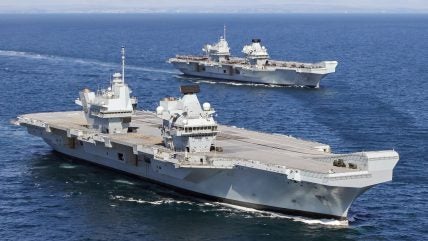
The unfortunate short history of the Queen Elizabeth-class aircraft carriers operated by the UK Royal Navy has added another entry, with the development that HMS Queen Elizabeth, lead ship in the class, will no longer kickstart Nato’s Exercise Steadfast Defender.
Posting on the X social media platform on 3 February 2024, the Royal Navy stated that “routine pre-sailing checks” undertaken on 2 February had identified “an issue with a coupling on [HMS Queen Elizabeth] starboard propellor shaft”.
As such, the vessel “will not sail on Sunday” to join Exercise Steadfast Defender, with its sister ship HMS Prince of Wales, itself only recently returned to sea following its own propellor shaft issues, due to take its place “as soon as possible”.
“It’s not uncommon to have maintenance issues with state-of-the-art ships which contain complex engineering and technology. Having two aircraft carriers means that HMS Prince of Wales can quickly prepare to deploy in place of HMS Queen Elizabeth,” a Royal Navy spokesperson told Naval Technology.
“HMS Prince of Wales will deploy soon on Nato exercise Steadfast Defender, carrying out her duties to keep the nation and our allies safe.”
The unwelcome news that a mechanical issue, particularly surrounding propulsion, comes at a time when their unavailability will prompt questions as to whether these are teething issues experienced by a class of relatively new warships, or something more complicated.
The Queen Elizabeth class: a history of troubles
In August 2022 HMS Prince of Wales encountered issues related to the carrier’s starboard propellor shaft, which brought the vessel’s intended Atlantic crossing to participate in exercises off the US eastern seaboard to a sudden halt.
After several weeks spent alongside the Princess Royal Jetty, where the vessel’s 33-tonne starboard propellor was removed, HMS Prince of Wales was dispatched, under reduced speed, to Babcock’s Rosyth Dockyard in the Firth of Forth for drydock repairs. The vessel subsequently drydocked at Rosyth dockyard, where it was built, for rectification work.
Subsequent UK parliamentary data into at-sea and repair days revealed in May 2023 that HMS Prince of Wales had spent nearly 33% of its time commissioned in the Royal Navy undergoing repairs. It’s time at sea was even lower, at just 21.3%.
As reported by Naval Technology at the time, in the 1,251 days since the carrier was commissioned into service the vessel has spent just 267 days at sea, with 411 days spent alongside or in dock undergoing repairs.
Commissioned into service in December 2019, issues have been a constant presence for the vessel, which in October 2020 sustained major flooding in its engine room following a burst fire main which caused significant damage to its electrical switchboards.
By contrast, HMS Queen Elizabeth completed a global deployment in 2021, operating in the Mediterranean, Indian Ocean, and Asia-Pacific region, fully integrating a US Marine Corps F-35B unit alongside its own embarked air wing.
However, in November 2021 a UK-operated F-35B fighter crashed into the Mediterranean Sea after taking off from HMS Queen Elizabeth, sparking a recovery effort to ensure that technology did not fall into Russian hands, which operates a number of vessels in the region.
Following an investigation, it was disclosed that the UK F-35B had ingested a cover that protects the engine air intake when the aircraft is inactive, which had not been removed prior to take-off.
The advantage of having two carriers
Despite these issues, it should be mentioned that in all cases of one of the UK carriers sustaining propulsion or other issues, its sister ship has been able, if not immediately, then relatively quickly, to take its place. In example, HMS Queen Elizabeth also split from its own exercise programme in 2022 to deputise for HMS Prince of Wales as host vessel for the Atlantic Future Forum in New York Harbour.
Similarly, HMS Prince of Wales will now depute for the Queen Elizabeth on Exercise Steadfast Defender, although no public timeframe has been given as to when it will head to sea. The Nato exercise is due to run until May, so any serials that would have incorporated a UK carrier can be adjusted.
Nevertheless, discussions about the usability of the UK carriers – which were not dispatched to replace a US Navy carrier strike group that departed the Mediterranean late last year and the new doubts raised about their ability to potentially replace USS Dwight D Eisenhower in the Red Sea in light of the latest setback – will persist.








